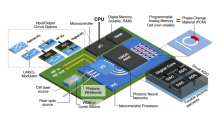Feb 1 2021
Researchers from the University of Exeter have now offered an interesting new understanding of the future steps to create energy-efficient, fast modern computing systems that use light in the place of electrons to process and store information.
 Conceptual layout of a future photonic neuromorphic computer. Image credit: Thomas Ferreira de Lima.
Conceptual layout of a future photonic neuromorphic computer. Image credit: Thomas Ferreira de Lima.
The new technology involves using hardware based directly on the functioning of the human brain.
Scientists, including Professor C. David Wright from the University of Exeter, have investigated the future potential for computer systems based on photonics instead of traditional electronics.
The focus of the study, which was published in the renowned journal Nature Photonics on January 29th, 2021, is to find prospective solutions to one of the world’s most crucial computing problems—ways to create computing technologies to process the data quickly and with energy efficiency.
Modern computers are based on the von Neumann architecture, where the fast Central Processing Unit (CPU) is physically isolated from the comparatively slower program and data memory.
This implies that computing speed is restricted and there is wastage of power due to the need to perform continuous transfer of data to and from the memory and processor over energy inefficient and bandwidth limited electrical interconnects—called the von Neumann bottleneck.
Thus, it has been predicted that over 50% of the power of modern computing systems is simply wasted in this transfer of data.
Clearly, a new approach is needed—one that can fuse together the core information processing tasks of computing and memory, one that can incorporate directly in hardware the ability to learn, adapt and evolve, and one that does away with energy-sapping and speed-limiting electrical interconnects.
C David Wright, Study Co-Author and Professor, Department of Engineering, University of Exeter
Photonic neuromorphic computing is one such technique where signals are transferred and processed using light instead of electrons, thereby providing access to considerably higher bandwidths (processor speeds) and great decreases in energy losses.
The research team made efforts to make the computing hardware itself isomorphic using a biological processing system (brains), by creating devices that directly simulate the fundamental functions of brain neurons and synapses.
They then connected these together in networks that can provide parallelized, quick, adaptive processing for machine learning and artificial intelligence applications.
The cutting edge of such photonic 'brain-like' computing, and its probable future development, is the focus of the study titled 'Photonics for artificial intelligence and neuromorphic computing' by a leading international team of scientists from the United States, Germany, and the United Kingdom.
Journal Reference:
Shastri, B. J., et al. (2021) Photonics for artificial intelligence and neuromorphic computing. Nature Photonics. doi.org/10.1038/s41566-020-00754-y.